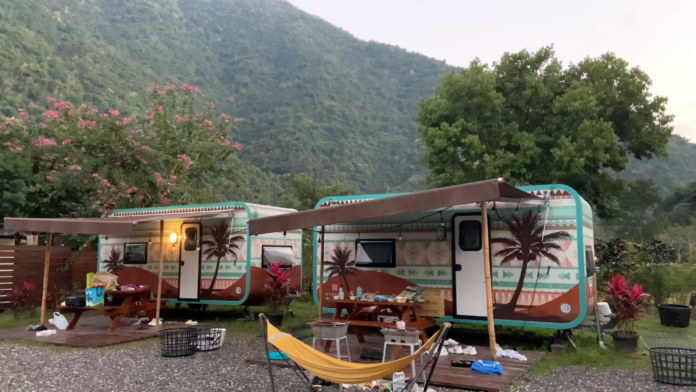Camping is a growing trend worldwide, and people enjoy it for countless reasons. Some adore camping to spare time with family and friends; Some love camping because it gives them a chance to be in nature; some go camping for more social life and human interaction due to the fast pace of city life and technological advancement; some use camping as a getaway from the crowd and enjoy their moment of silence.
Transportation and car preference are among the most essential elements in camping. People use their vehicles to carry items; some even sleep in cars. The car choice is indeed a crucial consideration for every camper. Speaking about car preference, electric vehicles (EVs) are becoming a more popular option in the car market nowadays. EVs are essentially safer than traditional fossil fuel cars because their power source is batteries, which are less flammable than internal combustion engines (Marshall, 2024). EVs also offer extra storage space because the engines are gone, and we call that front trunk space “frunk.”
However, since the frunk is a new space for car designers and manufacturers, the current frunk designs have very few storage and organization options, and the functionality is limited. This raised two critical questions: what is the current frunk design missing? And what are current campers missing? Given that electric vehicles have an additional cargo area that is not ideal for camping, I would like to explore the opportunities to utilize this space for the campers, and I believe that there’s a space in the market to design a frunk with campers in mind. This will lead to my focus area on how the frunk space enhances the overall camping experience.
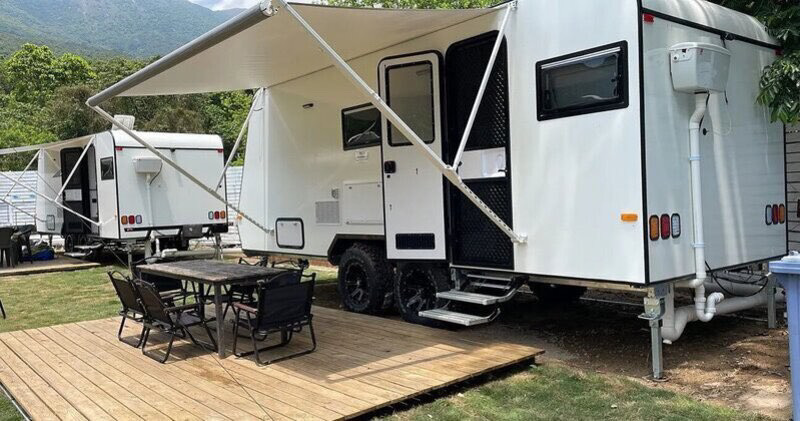
For my primary research, I interviewed one of my survey participants—Angelina, a senior welding engineering student from Taiwan. Her most recent camping experience was in an RV camp with seven high school friends. They first gathered in one place and then divided into three SUVs to go to the campground. Each group brought food and drinks and also carried everyone’s individual luggage. She said it was fortunate that they didn’t have to worry about tents and other camping equipment because they could barely fit everything in three SUVs. “I was not expecting just food and personal items would take up so much space,” Angelina said. “I wish we could have more space.” When asked if she would consider EVs with frunk, an additional storage space, for future camping, the answer is positive. To follow up, I asked her how she would use this extra space and what items she would put in there. She said that food would be the first consideration. She added, “I would love to put all my food and drinks in there, especially ones with smells.” She continued, “I don’t like the smell of food in my car. If I can put all the food in the frunk, then I don’t have to breathe that smell while driving. It would be very nice.” Finally, she shared that extra storage space will be highly beneficial for campers. The campsite they went to already provided living space and many essentials, but extra storage space would be crucial for tent camping, which requires more equipment.
To enhance the camping experience, the frunk should support campers in minimizing camping equipment. In the article about camping essentials and tips, the author states that camping is an activity that can easily lead to overpacking. Bringing things that aren’t functional for your personal needs can turn a positive experience into a bad one (Shorr-Mckee, 2023). There is a dazzling array of camping equipment, and it is hard to pick the essentials. However, to have a better experience, campers should try to avoid overpacking. Bringing too much gear can impact your mobility and flexibility. You would not like to spend most of your time packing and tidying up your stuff. From the environmental standpoint, the more you bring, the more chance you will leave items behind and damage nature. It will be very unfortunate and ironic because camping is supposed to be an opportunity to interact with nature more.
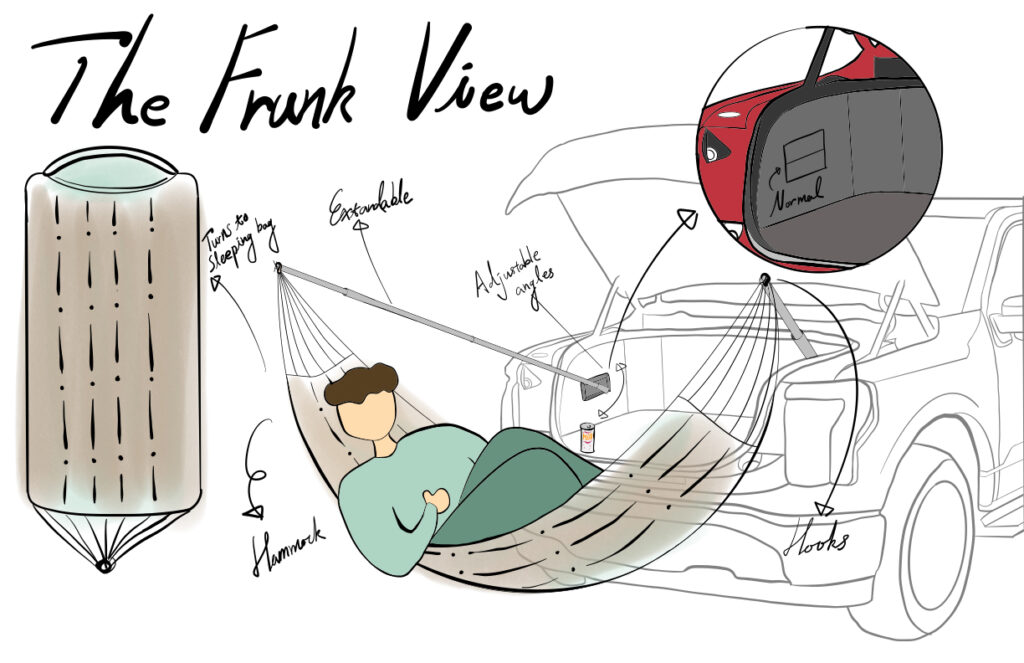
This idea leads to my design conjecture, the frunk view. This design is a built-in hammock that provides the camper with a way of relaxation. When taken off the hammock, it can transform into a sleeping bag, a camping gear that most campers will bring. With this design, people don’t have to bring an extra sleeping bag and poles to hang the hammock.
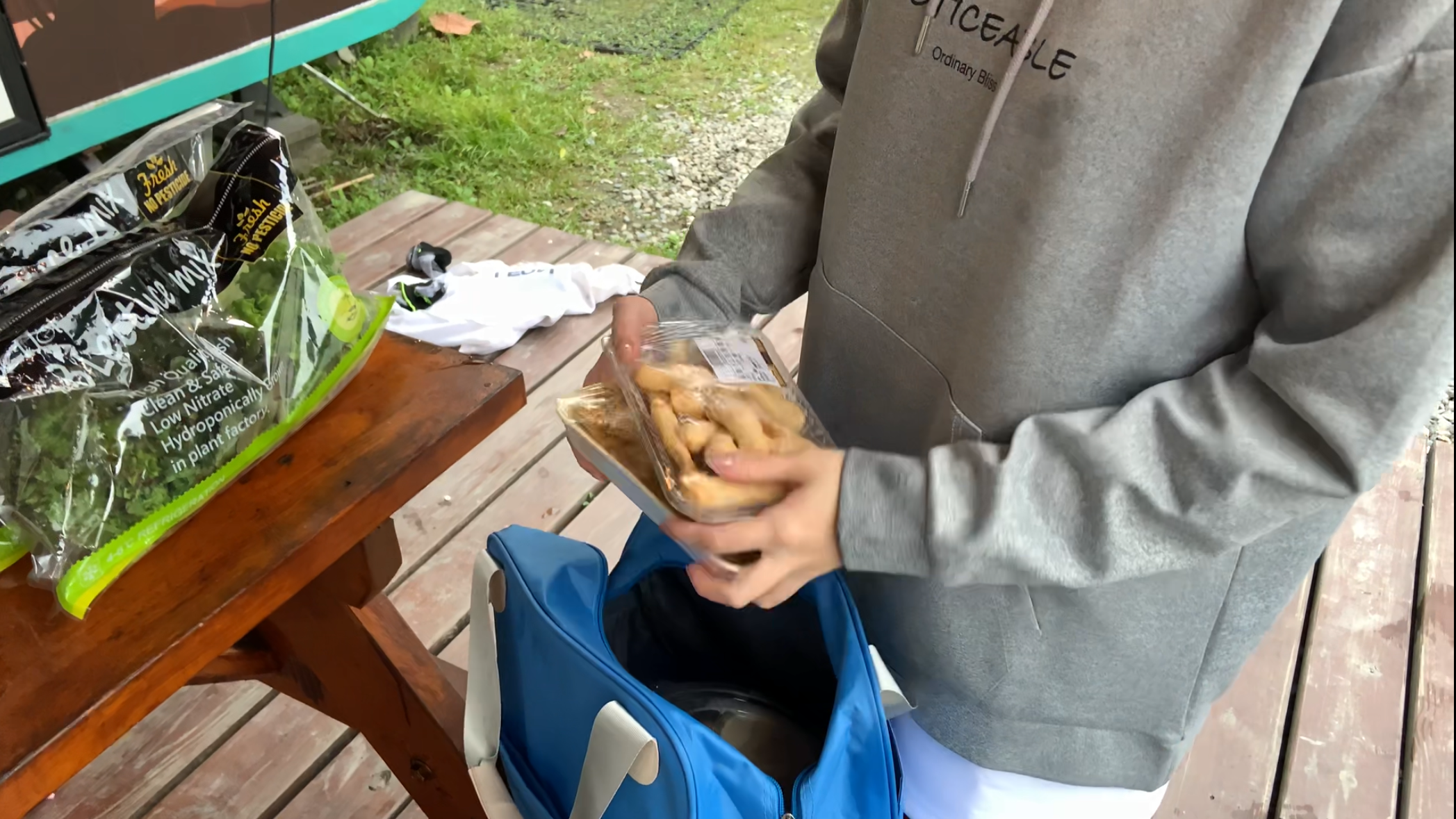
People bring all kinds of things when they go camping. And it is essential to keep them safe while driving and at the campsites. Among all the items, food is the one that’s harder to manage. Maintaining the temperature and humidity is important to keep them fresh and avoid discarding.
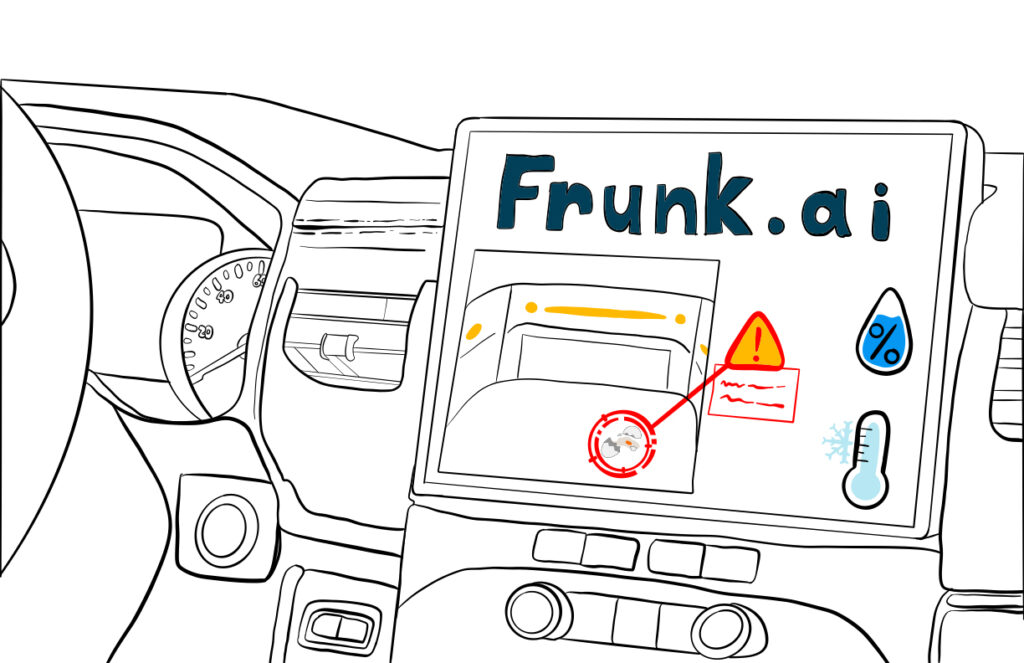
While reading the article about NVIDIA’s new AI sensor that is extremely powerful in object identification (Ciborowski, 2024), I came up with the idea called Frunk.ai, a system utilizing the AI camera sensors implemented in the frunk space. Frunk.ai can give the driver suggestions on organizing their belongings by calculating available spaces with the camera. When the sensor detects grocery items, the temperature and environmental control system will lower the temperature to keep them fresh.
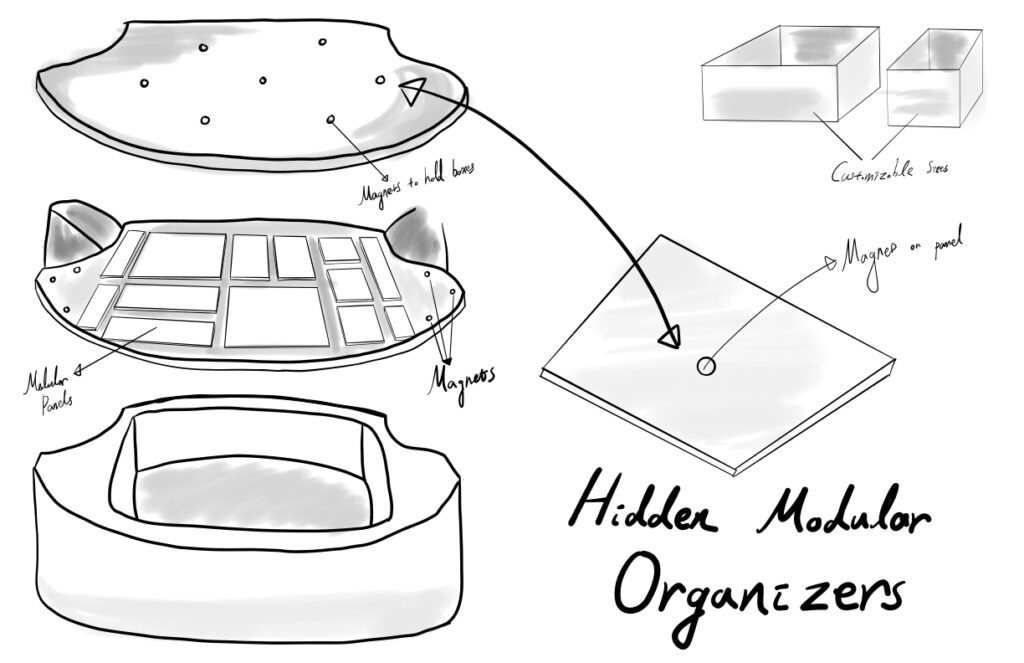
With an additional storage space, it feels wasteful not to utilize it for its potential. I believe the frunk should allow users to do customization and provide organization methods. After I watched the Netflix series “Resurrected Rides” (Scheer-Erb, 2024) and the article about custom furniture (Agnew, 2024), I deeply felt the value of customization—it is tailored toward the client’s needs and the sense of being cared for. In the context of camping, custom items and organization methods would be a significant enhancement. Different levels and types of camping could influence what you bring to the campground a lot. Some have already provided most of the essentials, while others require campers to bring everything alone. This leads to my design conjecture, named the hidden modular organizers. This design utilizes the fake floor in the frunk space to provide a customizable storage and organization strategy. The false floor is made up of two layers that are magnetized together. When separated, some insert panels in the middle layer can be formed into customizable-sized boxes for users to store all kinds of items. To prevent damaging items inside the boxes during the drive, the insert panels’ and the false floor’s magnets will secure the boxes securely to prevent tumbling.

At the beginning of my research process, I didn’t have a focus area yet, so I decided to survey how people manage their storage in their accommodations and moving options. I picked this survey topic because frunk space is also a storage area, and I believe I can translate the insights on storage methods from living spaces to vehicles. The survey audience is the group I have the most access to— Taiwanese international students from my student organization.
The most valuable takeaways from this survey are the organization and space-saving strategies. What I found was that organizing by category and maximizing vertical space are the most preferable strategies. Minimizing purchases and reorganizing regularly have the second-highest votes. Other notable methods are space-saving, multifunctional furniture, rotating seasonal items, and decluttering regularly. I found some of these answers fascinating because they’re transferable to camping and frunk areas. The vertical storage methods can be implemented on the false floor in the frunk; the multifunctional design is one of my focuses to help minimize camping equipment.
In this project, the campers, Honda, and the environment are the three primary stakeholders. The potential electric vehicles that Honda will manufacture and sell are targeting camping, a growing activity, and people who enjoy it. This new EV design aims to help campers bring fewer items to a campsite, which is better for the environment since less litter will be left behind. Moreover, electric vehicles are way more environmentally friendly since they do not create emissions. Honda creates eco-friendly and camper-centered vehicles, which will benefit both the campers and the environment by reducing waste and improving air quality, fostering a more sustainable and positive relationship between the three stakeholders.
In the article about Americans’ obsession with pickup trucks, the author states that people are buying pickups not just for practical use, but more people fall for them because of pursuing lifestyle and aesthetic reasons (Cowan, 2022). This reflects that Americans love driving larger vehicles for outdoor adventures, and it is already embedded in the U.S. car culture (Rogers, 2024). The relationship between vehicles and camping is very tight. The advancement of electric vehicles has also gradually changed the culture of camping. EVs operate more quietly than conventional vehicles, which can reduce the noise pollution in the campground. The built-in outlets are incredibly helpful in meeting different campers’ needs, providing convenience, and reducing gas-powered products (Valdes-Dapena, 2024).

Frunk and camping: one is a fresh terrain in car designs, and the other is a growing activity in years. While continuing to ask myself critically, what is the current frunk design missing? And what are the campers missing? I believe that the frunk has the potential to minimize camping gear that campers have to bring, making their trip more convenient and environmentally friendly. Offering customizable storage options can be tailored toward different campers’ needs. Finally, ensuring the safety of belongings, especially food’s freshness, can significantly alleviate campers’ concerns. Overall, I’m excited about designing this frunk intervention with Honda to enhance the camping experience.
Reference
Agnew, C. (2024, September 17). For homeowners, customized furniture provides ultimate creative control. The Globe and Mail. https://www.theglobeandmail.com/life/article-for-homeowners-customized-furniture-provides-ultimate-creative-control/
Ciborowski, J. (2024, August 29). Nvidia announces Omniverse Microservices to supercharge physical ai. NVIDIA Newsroom. https://nvidianews.nvidia.com/news/omniverse-microservices-physical-ai
Cowan, L. (2022). America’s love affair with pickup trucks. CBS News. https://www.cbsnews.com/news/americas-love-affair-with-pickup-trucks/
Marshall, A. (2024, September 15). The auto industry finally has a plan to stop electric vehicle fires. Wired. https://www.wired.com/story/the-auto-industry-finally-has-a-plan-to-stop-electric-vehicle-fires/
Rogers, O. (2024, April 12). The unique U.S. car culture. Alliance for Innovation and Infrastructure. https://www.aii.org/the-unique-u-s-car-culture/
Scheer-Erb, P. (2024, August 7). Netflix has its own version of Pimp my ride, and these are the crew members who make it happen. MovieWeb. https://movieweb.com/resurrected-rides-crew-members/
Shorr-Mckee , T. (2023, June 24). 15 genius camping must haves (plus bonus tips + hacks!). Chasing Trail. https://chasingtrailblog.com/list-of-genius-camping-must-haves/
Valdes-Dapena, P. (2024, March 31). Electric vehicles are changing how america goes camping | CNN business. CNN. https://www.cnn.com/2024/03/31/business/electric-vehicles-are-changing-how-america-goes-camping/index.html

